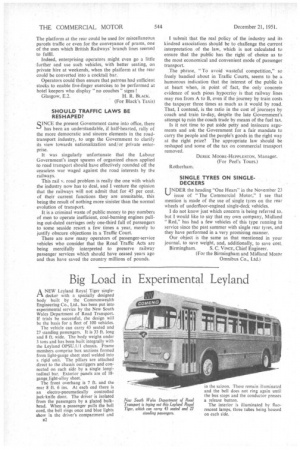Big Load in Experimental Leyland
Page 36

If you've noticed an error in this article please click here to report it so we can fix it.
A NEW Leyland Royal Tiger single1-1. decker with a specially designed body built by the Commonwealth Engineering Co., Ltd.. has been put into experimental service by the New South Wales Department of Road Transport. If trials be successful, the design will be the basis for a fleet of 100 vehicles.
The vehicle can carry 43 seated and 27 standing passengers. It is 33 ft. long and 8 ft. wide. The body weighs under 3 tons and has been built integrally with the Leyland OPSU.1/1 chassis. Frame members comprise box sections formed from light-gauge sheet steel welded into a rigid unit. The pillars are attached direct to the chassis outriggers and connected on each side by a single longitudinal bar. Exterior panels are of 18gauge light-alloy sheet.
The front overhang is 7 ft. and the rear 8 ft. 6 ins. At each end there is an electro-pneumatically controlled jack-knife door. The driver is isolated from the passengers by a glazed bulkhead. When a passenger pulls the bell cord, the bell rings once and blue lights show in the driver's compartment and
n2
in the saloon. These remain illuminated and the bell does not ring again until the bus stops and the conductor presses a release button.
The interior is illuminated by fluorescent lamps, three tubes being housed on each side.












































































